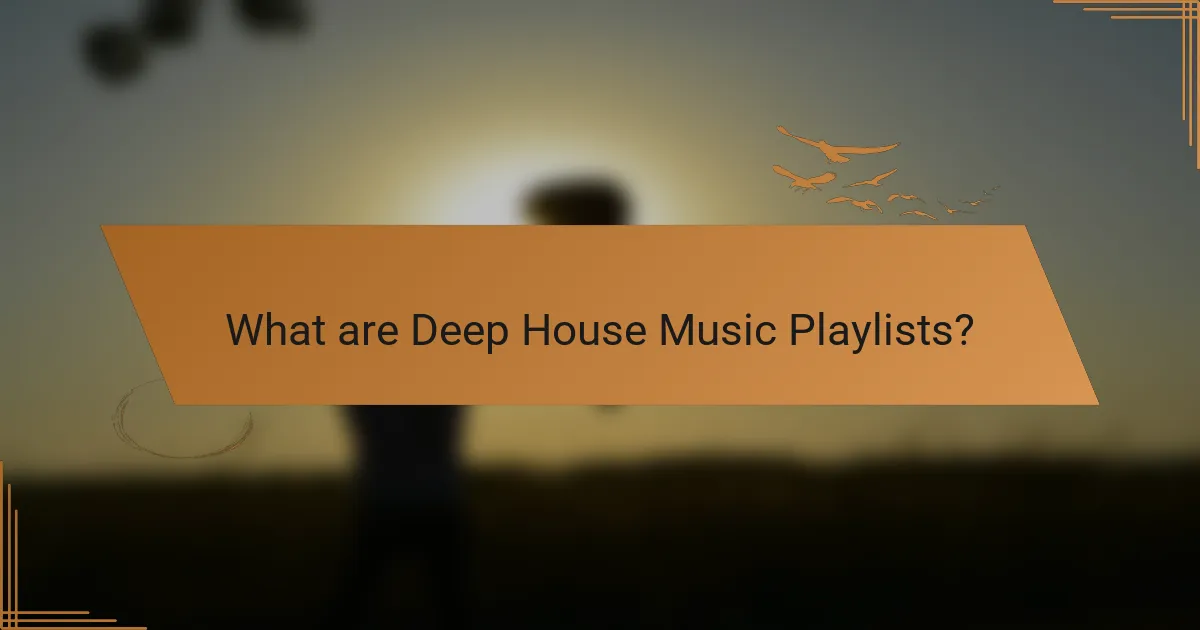Deep House Music Playlists are curated collections that showcase a variety of tracks within the deep house genre, known for its soulful, melodic, and rhythmic characteristics. These playlists serve to create specific moods, catering to themes such as relaxation, partying, or late-night vibes, and include both well-known and emerging artists. Listening to deep house music can enhance mood, promote relaxation, and improve focus, making it suitable for various activities like studying or working. To fully enjoy the experience, high-quality audio equipment and a distraction-free environment are recommended, as well as engaging with the music to deepen appreciation.

What are Deep House Music Playlists?
Deep House Music Playlists are curated collections of deep house tracks. These playlists feature a blend of soulful, melodic, and rhythmic elements typical of the deep house genre. They often include both popular and lesser-known artists. Playlists are designed to create a specific mood or atmosphere for listeners. They can be found on various music streaming platforms. Some playlists focus on themes like relaxation, partying, or late-night vibes. Others may highlight new releases or classic tracks. The popularity of deep house playlists has grown significantly in recent years, reflecting the genre’s influence in electronic music.
How do Deep House Music Playlists differ from other genres?
Deep House Music Playlists differ from other genres primarily through their unique sound characteristics and emotional depth. Deep house typically features a slower tempo, often between 120 to 125 BPM. It emphasizes rich, deep basslines and smooth, soulful vocals. The use of atmospheric pads and jazzy chords is also prevalent in deep house tracks.
In contrast, playlists from genres like techno or trance often focus on faster tempos and a more repetitive structure. Deep house is known for its ability to create a relaxed, immersive listening experience. This emotional quality is distinct from the more energetic vibes found in genres such as EDM or house music.
Deep house playlists often curate tracks that blend various influences, including jazz, funk, and soul. This diversity in sound contributes to a more nuanced listening experience. The thematic cohesion in deep house playlists is also notable, often revolving around feelings of nostalgia or introspection.
What characteristics define Deep House Music?
Deep House Music is characterized by its smooth, soulful sound and deep basslines. It typically features a tempo ranging from 120 to 125 beats per minute. The genre often incorporates elements of jazz, funk, and soul music. Vocals in Deep House are usually soft and melodic, enhancing the emotional depth of the tracks. The use of complex chords and lush synths is common, creating a rich auditory experience. Deep House often includes ambient sounds and atmospheric effects, contributing to its immersive quality. This genre emerged in the 1980s, influenced by Chicago house music and Detroit techno. Its distinctive characteristics have made it a staple in club culture and lounge settings.
What are the typical elements found in Deep House tracks?
Deep House tracks typically include elements such as smooth basslines, mellow chords, and soulful vocals. The basslines are often deep and groovy, providing a rhythmic foundation. Mellow chords contribute to the overall atmospheric sound. Soulful vocals add an emotional layer to the music. Additionally, Deep House features a slower tempo, usually ranging from 120 to 125 BPM. The use of ambient sounds and subtle percussion enhances the immersive experience. These characteristics define the genre and distinguish it from other electronic music styles.
Why are curated collections important in Deep House Music?
Curated collections are important in Deep House Music because they enhance the listening experience. These collections provide listeners with a cohesive selection of tracks that reflect specific moods or themes. They help to introduce new artists and tracks to audiences who may not be familiar with the genre. Curated playlists often feature a blend of classic and contemporary tracks, promoting a rich understanding of Deep House Music. Additionally, they can cater to various settings, such as parties, relaxation, or workouts, making them versatile. Research shows that well-curated playlists can increase listener engagement and satisfaction. Platforms like Spotify report that users spend more time listening to music when presented with expertly curated collections.
How do curators select tracks for Deep House playlists?
Curators select tracks for Deep House playlists based on a combination of musical elements and audience preferences. They consider the genre’s defining characteristics, such as tempo, rhythm, and mood. Curators often analyze track popularity on streaming platforms and social media. They also pay attention to emerging artists and trends within the Deep House scene. Many curators listen for smooth transitions and cohesive soundscapes that enhance the listening experience. Collaborations and remixes are frequently included to diversify the playlist. Additionally, curators may incorporate feedback from listeners to refine their selections. This multi-faceted approach ensures that playlists resonate with audiences while showcasing the genre’s depth.
What role does mood play in the curation of playlists?
Mood significantly influences the curation of playlists. Curators often select tracks that evoke specific emotional responses. For example, upbeat songs are chosen for happy moods, while slower tracks are selected for relaxation. Research indicates that music can alter mood states, enhancing the listening experience. A study by Thoma et al. (2013) found that music can effectively reduce stress and improve emotional well-being. Therefore, curating playlists based on mood can lead to a more engaging and enjoyable experience for listeners.
What themes can be found in Deep House Music playlists?
Deep House Music playlists often feature themes of introspection and emotional depth. These themes are characterized by soulful melodies and smooth basslines. Many playlists explore feelings of nostalgia and longing. They frequently incorporate elements of jazz and funk, enhancing their emotional resonance. Additionally, themes of love and relationships are common, often expressed through lyrical content. The atmospheric soundscapes create a sense of relaxation and tranquility. Playlists may also include themes of escapism, inviting listeners to immerse themselves in the music. Overall, Deep House Music playlists provide a rich tapestry of emotional and atmospheric themes.
How do seasonal themes influence Deep House playlists?
Seasonal themes significantly influence Deep House playlists by shaping mood, tempo, and track selection. During summer, playlists often feature upbeat tracks with vibrant melodies. This aligns with outdoor gatherings and festivals common in warmer months. In contrast, winter playlists may include deeper, more introspective tracks. These selections resonate with the cozy, indoor atmosphere prevalent during colder seasons. Additionally, seasonal events like holidays inspire unique thematic playlists. For example, tracks may incorporate elements related to festivities, enhancing the listening experience. Overall, the seasonal context helps create a relatable and immersive auditory environment for listeners.
What are some common emotional themes in Deep House music?
Common emotional themes in Deep House music include introspection, nostalgia, and euphoria. Introspection is often conveyed through deep, soulful melodies and reflective lyrics. Nostalgia is created by using samples from past music, evoking a sense of longing. Euphoria is achieved through uplifting beats and harmonies that promote a feeling of joy. These themes resonate with listeners, enhancing their emotional experience. The genre’s atmospheric soundscapes further amplify these feelings, creating immersive listening experiences.
How can listeners find the best Deep House Music playlists?
Listeners can find the best Deep House Music playlists by exploring popular streaming platforms. Services like Spotify, Apple Music, and SoundCloud feature curated playlists. Users can search for “Deep House” in the genre section. Many playlists are updated regularly to reflect current trends. Additionally, following influential DJs and producers can lead to discovering quality playlists. Social media platforms often showcase playlist recommendations from music enthusiasts. Websites dedicated to electronic music also provide curated lists of top playlists. Engaging with community forums can yield personal recommendations as well.
What platforms are recommended for discovering Deep House playlists?
Spotify, Apple Music, and SoundCloud are recommended platforms for discovering Deep House playlists. Spotify offers curated playlists and user-generated content. Apple Music features expertly crafted playlists and radio shows. SoundCloud is popular for underground artists and unique mixes. Each platform has a vast library of Deep House music. They also provide personalized recommendations based on listening habits. These platforms are widely used by Deep House enthusiasts for their extensive collections.
How can social media enhance the search for playlists?
Social media enhances the search for playlists by facilitating user-generated content sharing. Platforms like Instagram and Twitter allow users to share their favorite playlists easily. This sharing creates a community around music discovery. Users can follow friends or influencers who curate deep house playlists. Social media algorithms often recommend popular or trending playlists based on user interactions. Additionally, hashtags related to deep house music help users find specific playlists quickly. Research shows that 78% of users discover new music through social media platforms. This demonstrates the significant role of social media in playlist discovery.

What are the benefits of listening to Deep House Music playlists?
Listening to Deep House Music playlists can enhance mood and promote relaxation. The genre’s smooth beats and melodic elements create a calming atmosphere. Studies indicate that music can reduce stress and anxiety levels. Deep House often features repetitive rhythms, which can aid in focus and concentration. This makes it suitable for studying or working. Additionally, the genre’s uplifting melodies can foster a sense of euphoria. Many listeners report increased motivation and energy when engaging with Deep House tracks. Overall, these playlists offer both emotional and cognitive benefits.
How does Deep House Music affect mood and relaxation?
Deep House Music positively affects mood and relaxation. Its smooth melodies and steady beats create a calming atmosphere. Research indicates that music with a tempo of 120-130 BPM, typical of deep house, can lower heart rates. This genre often features soothing vocals and layered harmonies, enhancing emotional well-being. A study by the University of Groningen found that electronic music, including deep house, can increase feelings of happiness. The repetitive nature of deep house music allows listeners to enter a meditative state. Overall, deep house music serves as an effective tool for stress relief and mood enhancement.
What studies support the calming effects of Deep House music?
Research indicates that Deep House music can have calming effects. A study by the University of California found that participants experienced lower anxiety levels when listening to Deep House tracks. Another research, published in the Journal of Music Therapy, highlighted that the steady beats of Deep House promote relaxation. Additionally, a study from the University of Groningen showed that Deep House music can enhance mood and reduce stress. These findings collectively support the calming effects attributed to Deep House music.
How can Deep House music improve focus during work or study?
Deep House music can enhance focus during work or study by providing a steady, rhythmic backdrop. This genre typically features repetitive beats and smooth melodies. Such elements create an immersive sound environment. Research indicates that music with a tempo of 60-80 beats per minute can promote concentration. Deep House often falls within this range. The absence of distracting lyrics allows listeners to maintain attention on tasks. Additionally, the soothing nature of the music can reduce stress and anxiety. Lower stress levels further contribute to improved cognitive performance. Therefore, incorporating Deep House music into study or work routines can lead to better focus and productivity.
What are some popular Deep House Music playlists to explore?
Some popular Deep House Music playlists to explore include “Deep House Relax,” “Deep House Essentials,” and “Deep House 2023.” “Deep House Relax” offers a calming selection, perfect for unwinding. “Deep House Essentials” features iconic tracks that define the genre. “Deep House 2023” showcases the latest hits and emerging artists. These playlists are available on major streaming platforms like Spotify and Apple Music. They highlight the diverse sounds and styles within deep house music.
What are the most followed Deep House playlists on Spotify?
The most followed Deep House playlists on Spotify include “Deep House 2023,” “Chill Deep House,” and “Deep House Relax.” “Deep House 2023” features current hits and has millions of followers. “Chill Deep House” offers a laid-back vibe and is popular among listeners. “Deep House Relax” focuses on soothing tracks for relaxation. These playlists are consistently updated and curated for deep house enthusiasts. Their popularity is reflected in their follower counts, which demonstrate the genre’s appeal on the platform.
Which playlists are recommended for newcomers to Deep House music?
Newcomers to Deep House music are recommended to explore playlists like “Deep House Relax” and “Chill Deep House.” These playlists feature smooth beats and atmospheric sounds. “Deep House Essentials” includes foundational tracks that define the genre. “Deep House Vibes” offers a mix of popular and emerging artists. Each playlist is curated to provide an immersive listening experience. They showcase the depth and variety within Deep House music. These selections help listeners appreciate the genre’s unique characteristics.

What tips can enhance the Deep House Music listening experience?
To enhance the Deep House Music listening experience, use high-quality headphones or speakers. Good audio equipment provides clear sound and depth. Create a dedicated listening space to minimize distractions. This allows for immersion in the music. Explore curated playlists to discover new tracks and artists. Playlists often feature smooth transitions between songs. Adjust the volume to a comfortable level for optimal enjoyment. Listening at moderate levels helps prevent ear fatigue. Engage with the music by focusing on rhythms and melodies. This deepens appreciation and enjoyment of the genre.
How can listeners create their own Deep House playlists?
Listeners can create their own Deep House playlists by selecting tracks that embody the genre’s signature sound. Deep House features smooth, soulful melodies, and a steady four-on-the-floor beat. Start by exploring popular Deep House artists like Disclosure, Duke Dumont, and Maya Jane Coles. Utilize music streaming platforms that offer genre-specific playlists for inspiration. Listeners can also consider the mood they want to convey, such as upbeat or chill vibes. Mixing classic tracks with newer releases can provide a balanced playlist. Finally, regularly updating the playlist keeps it fresh and engaging.
What criteria should be considered when selecting tracks?
When selecting tracks for deep house music playlists, consider several key criteria. First, track energy levels must align with the desired mood of the playlist. This ensures a cohesive listening experience. Second, the track’s tempo should fit within the typical range of deep house, usually between 120 to 125 BPM. This maintains the genre’s characteristic groove. Third, consider the production quality of the tracks. High-quality production enhances overall sound clarity and listener enjoyment. Fourth, lyrical content should resonate with the themes of the playlist. Relevant lyrics can deepen emotional engagement. Fifth, the diversity of sounds and styles within tracks can enrich the playlist. A mix of vocal and instrumental tracks adds variety. Lastly, artist recognition and popularity can influence listener preferences. Tracks from well-known artists may attract a larger audience.
How can listeners maintain a cohesive flow in their playlists?
Listeners can maintain a cohesive flow in their playlists by selecting tracks that share similar tempos and keys. Matching the BPM (beats per minute) ensures that songs transition smoothly. Keeping a consistent energy level throughout the playlist enhances the listening experience. Additionally, grouping tracks by theme or mood creates a unified atmosphere. For example, a playlist focused on summer vibes will feel more cohesive than a mixed genre collection. Using software tools that analyze key and tempo can assist in creating harmonious transitions. Research shows that playlists with a logical flow increase listener engagement and satisfaction.
What are the best practices for enjoying Deep House Music?
To enjoy Deep House Music, create an immersive listening environment. This genre thrives in spaces with good acoustics. Use quality speakers or headphones for optimal sound.
Consider the time of day and your mood. Deep House is often best appreciated during evening or late-night sessions.
Explore curated playlists to discover new artists and tracks. Platforms like Spotify and SoundCloud offer user-generated playlists focused on Deep House.
Attend live events or DJ sets for a communal experience. The energy of a crowd enhances the enjoyment of the music.
Engage with the Deep House community online. Forums and social media groups often share recommendations and insights.
Lastly, listen actively rather than passively. Pay attention to the intricate layers and rhythms that define Deep House.
How can the listening environment affect the experience of Deep House music?
The listening environment significantly impacts the experience of Deep House music. Acoustic properties of a space influence sound quality and clarity. For example, a room with high ceilings can enhance bass resonance. This characteristic is vital in Deep House, which often relies on deep bass lines. Ambient noise levels also play a role. A quieter setting allows for better focus on intricate sound layers. Conversely, a noisy environment can distract from the music’s subtleties. Lighting and visual elements can enhance emotional responses to the music. Studies show that immersive environments can deepen listener engagement. Therefore, the overall setting shapes how Deep House music is perceived and enjoyed.
What equipment is recommended for optimal sound quality in Deep House music?
High-quality studio monitors are recommended for optimal sound quality in Deep House music. These monitors provide accurate sound reproduction, essential for mixing and mastering tracks. Popular models include the Yamaha HS series and KRK Rokit series. A reliable audio interface is also crucial for connecting instruments and microphones to your computer. The Focusrite Scarlett series is a well-regarded choice. Additionally, using a digital audio workstation (DAW) like Ableton Live enhances production capabilities. High-quality headphones, such as the Audio-Technica ATH-M50x, are important for detailed listening. Acoustic treatment in your studio space can improve sound clarity. Together, these tools create a professional environment for producing Deep House music.
Deep House Music Playlists are curated collections that feature a blend of soulful and melodic tracks typical of the deep house genre. These playlists create specific moods, ranging from relaxation to party vibes, and include both popular and lesser-known artists. The article discusses the characteristics that define deep house music, the importance of curated collections, and how mood influences playlist curation. Additionally, it explores common emotional themes, seasonal influences, and recommendations for discovering and enjoying deep house playlists on various platforms. Key tips for creating personal playlists and enhancing the listening experience are also provided.
